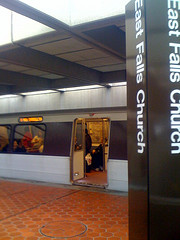Is Metro Parking Under-priced? For Whom?
There’s a thought-provoking post up over at Greater Greater Washington about how VDOT wants to retain all the parking (if not increase it, in the future) which currently exists near the East Falls Church Metro stop.
VDOT cites the early fill time for the parking lot as justification for considering more parking than already exists. The lot regularly fills before 7:30 am, and data obtained from Metro cites the lot as one of the region’s most crowded.
The author of the post, Michael Perkins, thinks that the lot fills regularly because it is under-priced.
More crowded parking lots should have higher prices to encourage drivers to use alternate means of access like cycling, walking, or bus, or to choose another, less crowded lot. The additional revenue could be devoted to improving sidewalks and trails locally, increase the amount of parking for bicycles, or to improve feeder bus service.
I hear what he’s saying, but I can’t help but wonder if issues of class are also at play here. Not everyone lives close enough to bike or walk to a station. The fact that a parking lot fills up quickly doesn’t mean that the people filling it could bear an additional financial burden to park there. Perkins supports transforming such outer-lying metro stations from “Park and Ride” hubs to more “urban” clusters of housing and businesses.
The problem is, housing near Metro stations is more expensive because of its proximity to public transportation. I can walk to the Metro entrance on the side of my apartment building because I am paying a premium to live in it. People who have been priced out of the city or its closest suburbs drive to “Park and Ride” stations out of necessity, not because it’s cheap to park there. Increase the price to park at Metro’s lots and they may just abandon public transit entirely– and drive in to the city, instead.






